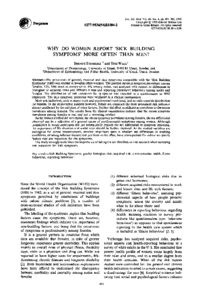Why do women report "sick building symptoms" more often than men?

1995
40
4
491-502
biological risks ; gender ; individual susceptibility ; risk assessment ; sick building syndrome ; work environment
Risk assessment and risk management
English
Bibliogr.
"The prevalence of general, mucosal and skin symptoms compatible with the 'Sick Building Syndrome' (SBS) was studied in Swedish office workers. The marked excess in symptom prevalence among females, 12% SBS cases as compared to 4% among males, was analysed with respect to differences in biological or acquired risks and different illness and reporting (interview) behaviour among males and females. Most risk indicators, such as paper work and psychosocial work load, had an unfavourable distribution for females. In the multivariate analysis however, female sex remained the most prominent risk indicator almost unaffected by the addition of other factors. Neither did effect modification contribute to the excess prevalence among females. The results from the clinical examination indicate that the excess symptom prevalence among females is real and not a reporting artefact. As the factors studied did not explain the excess symptom prevalence among females, the sex differential observed can be a reflection of a general excess of psychosomatic symptoms among women. Although inequalities in social conditions did not substantially explain the sex differential in symptom reporting, the importance of life situation and social roles should be further explored. As the studied variables are surrogates for actual measurements, another important issue is whether sex differences in working conditions, entailing different hierarchical positions in the office, have consequences for indoor air quality factors that are important for the symptoms. The study strongly underlines the importance of taking the sex distribution into account when surveying risk indicators for SBS symptoms."
Digital
The ETUI is co-funded by the European Union. Views and opinions expressed are however those of the author(s) only and do not necessarily reflect those of the European Union or the ETUI.